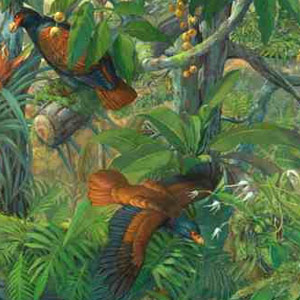Magazine | Interviews
Rebecca Stirnemann et le « petit dodo » des îles Samoa

Diduncules strigirostres (Didunculus strigirostris) adultes dans son habitat forestier dans les îles Samoa.Dessin : Michael Rothman
Introduction
L’archipel des Samoa forme un état polynésien indépendant composé de deux îles principales (Upolu et Savaii), de deux îles plus petites (Manono et Apolima), et de six îlots inhabités. Ces terres sont d’origine volcanique. Elles sont également en grande partie montagneuses : le plus haut sommet, le Mauga Silisili, culmine à 1 858 mètres d’altitude.
Le climat est tropical avec une saison des pluies commençant en novembre et se terminant en avril. Les forêts couvraient autrefois la totalité de ces îles, mais le développement agricole, aggravé par les effets des cyclones, a entraîné la destruction d’une grande partie des forêts naturelles, en particulier dans les plaines.
81 espèces d’oiseaux ont été recensées sur les Samoa, dont dix sont endémiques (l’une d’entre elles, la Gallinule punaé, a probablement disparu).
Le Diduncule strigirostre (Didunculus strigirostris), appelé « Manumea » en polynésien, est l’oiseau symbole des Samoa : ce pigeon étrange, apparenté aux dodos disparus, est très menacé et est en voie de disparition (il ne resterait que 200 individus), à cause de la destruction de son habitat et de la prédation des rats et des chats introduits.
Rebecca Stirnemann, une biologiste qui travaille depuis trois ans sur le Méliphage mao, un autre oiseau endémique des Samoa, étudie et se bat également pour la protection du diduncule. Elle a répondu à nos questions.
Jusqu’au 17 avril 2014, vous pouvez contribuer à la protection du Diduncule strigirostre : plus d’informations sur la page de dons intitulée « Saving the last Manumea, Samoa’s little dodo ».
Abstract
Samoa consists of two main islands namely Upolu and Savaii, and seven smaller islands that lie in the South Pacific Ocean. All the islands of Samoa were formed by volcanic activity. Savaii and Upolu have central mountain ridges formed from a chain of volcanic peaks and craters, reaching 1858 meters at the highest point. The Samoa islands were once completely covered by indigenous lowland and upland rainforests with wetlands mostly along the coastal areas and mixed upland swamp forest. Since the mid 1800’s, when commercial farming operations were introduced, a large part of the native forests, primarily in lowlands, were cleared for cultivation. Currently, 81 bird species have been recorded in Samoa, including ten endemics (one of them, the Samoan Moorhen , is possibly extinct). The Tooth-billed Pigeon (Didunculus strigirostris) is the national bird of Samoa, but it is endangered and is now present in only a few locations (surveys suggest that less than 200 birds remain).
Rebecca Stirnemann is a biologist : she has been studying the Ma’oma’o, an endangered species of honeyeater endemic to Samoa, for three years. She’s also working for the protection of the Manumea. She answered our questions about this fascinating species.
Up to the 17th April 2014, you can help for the protection of the Tooth-billed Pigeon : more informations on the page Saving the last Manumea, Samoa’s little dodo.
Poursuivez la lecture de cet article, en vous abonnant dès maintenant !
Découvrez les Archives d’Ornithomedia.com
Pour seulement 10,00 €TTC/an (ou 6,00 € les 6 mois)
Profitez de plusieurs centaines d’articles en accès illimité et sans aucun engagement.
Compléments
Contact
Rebecca Stirnemann – Courriel : rstirnemann@gmail.com – Site web : samoanbirds.com.
Ouvrages recommandés
- A Guide to the Birds of Fiji and Western Polynesia: Including American Samoa, Niue, Samoa, Tokelau, Tonga, Tuvalu de Dick Watling
- Manu, les oiseaux de Polynésie de Société d’Ornithologie de Polynésie Française
- Rarotonga, Samoa & Tonga de AA. VV.
Sources
- Jeremy Hance (2013). Extinction warning: racing to save the little dodo from its cousin’s fate. Mongabay. http://news.mongabay.com/2013/0304-hance-little-dodo.html
- Birdlife International et al. Important birds areas of Smoa. Juan Fernández Islands. http://www.sprep.org




Aucun commentaire sur ce sujet
Participer à la discussion !